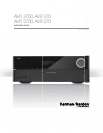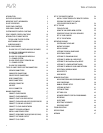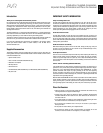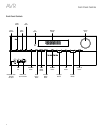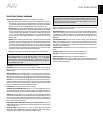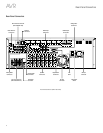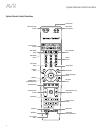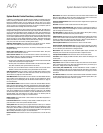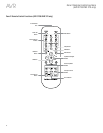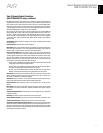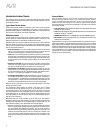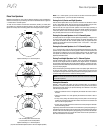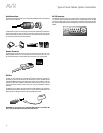
ENGLISH
AVR
Rear-Panel Connectors
7
Rear-Panel Connectors, continued
Radio Antenna connectors: Connect the supplied AM and FM antennas to their
respective terminals for radio reception.
Wi-Fi
®
Antenna connector (AVR 3700/AVR 370): If your home network is Wi-Fi,
connect the supplied Wi-Fi antenna here to enjoy Internet radio and content from DLNA
®
-
compatible devices that are connected to the network. You do not need to make a wired
network connection.
Network connector: If your home network is wired, use a Cat. 5 or Cat. 5E Ethernet
cable (not supplied) to connect the AVR’s Network connector to your home network to
enjoy Internet radio and content from DLNA-compatible devices that are connected to the
network. See Connect to Your Home Network, on page 20, for more information.
HDMI
®
Input connectors: An HDMI connection transmits digital audio and video signals
between devices. If your source devices have HDMI connectors, using them will provide
the best possible video and audio performance quality. Since the HDMI cable carries
both digital video and digital audio signals, you do not have to make any additional audio
connections for devices you connect via the HDMI connection. See Connect Your Audio
and Video Source Devices, on page 18, for more information.
HDMI Output connectors: If your TV has an HDMI connector, use an HDMI cable (not
included) to connect it to the AVR’s HDMI Out connector. The AVR will automatically
transcode component and composite video input signals to the HDMI format (upscaling
to as high as 1080p), so you do not need to make any other connections to your TV from
the AVR or from any video source devices you connect to the AVR. NOTE: The AVR 3700
and AVR 370 have two HDMI Out connectors.
Notes on using the HDMI Output connector:
sWhen connecting a DVI-equipped display to the HDMI Out connector, use an
HDMI-to-DVI adapter and make a separate audio connection.
sMake sure the HDMI-equipped display is HDCP (High-bandwidth Digital Content
Protection)-compliant. If it isn’t, do not connect it via an HDMI connection; use an
analog video connection instead and make a separate audio connection.
Analog Video connectors: The following Analog Video connectors are provided:
sComposite Video Input connectors: Use composite video connectors for video
source devices that don’t have HDMI or component video connectors. You will also
need to make an audio connection from the source device to the AVR. See Connect
Your Audio and Video Source Devices, on page 18, for more information.
sComponent Video Input connectors: If any of your video source devices have
component video connectors (and do not have HDMI connectors), using the
component video connectors will provide superior video performance. You will also
need to make an audio connection from the device to the receiver. See Connect Your
Audio and Video Source Devices, on page 18, for more information.
sComposite Video Monitor Out connector: If your TV or video display does not
have an HDMI connector, use a composite video cable (not included) to connect the
AVR’s Composite Video Monitor Out connector to your TV ’s composite video input.
NOTE: The HDMI connection to your TV is preferred. If you use the composite video
connection to your TV, you will not be able to view the AVR’s on-screen menus.
Analog Audio connectors: The following analog audio connectors are provided:
sAnalog Audio Input connectors: Use the AVR’s Analog Audio Input connectors for
source devices that don’t have HDMI or digital audio connectors. See Connect Your
Audio and Video Source Devices, on page 18, for more information.
sAnalog Rec[ord] Out connectors: Connect this analog audio output to the analog
audio input of a recording device. A signal is available at this output whenever an
analog audio source is playing.
sZone 2 Out connectors: Connect these jacks to an external amplifier to power the
speakers in the remote zone of a multizone system.
Pre-Out connectors (AVR 3700/AVR 370): Connect these jacks to external amplifiers if
more power is desired. The function of the Surround Back/Front Height/Zone 2 connectors
is determined by the setting you make for the Assigned Amp. See Manual Speaker Setup:
Number of Speakers, on page 38, for more information.
Subwoofer connector: Connect this jack to a powered subwoofer with a line-level input.
See Connect Your Subwoofer, on page 17, for more information. NOTE: The AVR 3700 and
AVR 370 have two subwoofer connectors.
IR and Trigger connectors: The following IR and trigger connectors are provided:
sIR Remote In/Out connectors: When the IR sensor on the front panel is blocked
(such as when the AVR is installed inside a cabinet), connect an optional IR receiver
to the IR Remote In jack. The IR Remote Out jack may be connected to the IR input of
a compatible product to enable remote control through the AVR.
sZone 2 IR Input connector: Connect a remote IR receiver located in Zone 2 of a
multizone system to this jack to control the AVR (and any source devices connected
to the Remote IR Output connector) from the remote zone.
s12V Trigger connector: This connector provides 12V DC whenever the AVR is on. It
can be used to turn on and off other devices such as a powered subwoofer.
Speaker connectors: Use two-conductor speaker wire to connect each set of terminals
to the correct speaker. See Connect Your Speakers, on page 17, for more information.
NOTE: The Assigned Amp speaker connectors are used for the surround back
channels in a 7.1- channel home theater, or you can reassign them to a remote room
for multizone operation or to front height channels for Dolby
®
Pro Logic IIz operation.
See Place Your Speakers, on page XX, for more information.
Digital Audio connectors: If your non-HDMI source devices have digital outputs,
connect them to the AVR’s digital audio connectors. NOTE: Make only one type of digital
connection (HDMI, optical or coaxial) from each device. See Connect Your Audio and Video
Source Devices, on page 18, for more information.
RS-232 connector: This connector is used to connect to external control hardware.
Consult a certified professional installer for more information.
Fan Vents: These vents are used by the AVR’s fan to cool the system. Maintain a
clearance of at least three inches (75mm) from the nearest surface to avoid overheating
the unit. It is normal for the fan to remain off at most normal volume levels. An automatic
temperature sensor turns the fan on only when it is needed.
IMPORTANT NOTE: Never block the fan vents. Doing so could allow the AVR to
overheat to dangerous levels.
Main Power switch: This mechanical switch turns the AVR’s power supply on or off. It is
usually left on, and it cannot be turned on or off using the remote control.
AC Input connector: After you have made and verified all other connections, plug the
supplied AC power cord into this receptacle and into an unswitched wall outlet.



